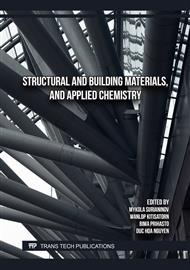[1]
J.W. Fu, F. Li, J.J. Sun, K. Cui, X.D. Du, Y.C. Wu, Effect of crystallographic orientations on the corrosion resistance of Fe-17Cr ferritic stainless steel, J. Electroanal. Chem, 841 (2019) 56–62.
DOI: 10.1016/j.jelechem.2019.04.031
Google Scholar
[2]
H.H. Lu, W.Q. Li, L.Y. Du, H.K. Guo, W. Liang, W.G. Zhang, Z.G. Liu, The effects of martensitic transformation and (Fe, Cr)23C6 precipitation on the properties of transformable ferritic stainless steel, Mater. Sci. Eng. A, 754 (2019) 502–511.
DOI: 10.1016/j.msea.2019.03.110
Google Scholar
[3]
Wang. W, Zhao. S, Tang. X, Chen. C, Stainless steel catalyst for air pollution control: structure, properties, and activity. Environ Sci Pollut Res 29(2022) 55367–55399.
DOI: 10.1007/s11356-022-21079-z
Google Scholar
[4]
K.A. Cashell, N.R. Baddoo, Ferritic stainless steels in structural applications, Thin-Walled Structures, 83 (2014), 169-181.
DOI: 10.1016/j.tws.2014.03.014
Google Scholar
[5]
Minh-Thuyet Nguyen, Van-Trung Trinh, Heat treatment for microstructure stabilizing of biomedical Ti-6Al-4V alloy fabricated by selective laser melting. MM Science Journal, October 2024.
DOI: 10.17973/mmsj.2024_10_2024060
Google Scholar
[6]
Schürmann, E., & Talha, M. Stainless Steel - Characteristics, Corrosion Resistance and Applications. IntechOpen (2019).
Google Scholar
[7]
Loto, R. T., & Stokes, J. Corrosion resistance study of 439L ferritic stainless steel subjected to high temperature variation. Cogent Engineering, 8 (2021).
DOI: 10.1080/23311916.2021.1893623
Google Scholar
[8]
Xiaoguang Ma, Jingwei Zhao, Wei Du, Xin Zhang, Zhengyi Jiang, Effects of rolling processes on ridging generation of ferritic stainless steel, Materials Characterization, 137(2018) 201-211.
DOI: 10.1016/j.matchar.2018.01.031
Google Scholar
[9]
Frazier, W.E. Metal Additive Manufacturing: A Review. J. of Materi Eng and Perform, 23 (2014) 1917–1928.
Google Scholar
[10]
Gibson I, Rosen D, Stucker B, Khorasani M, Additive manufacturing technologies, Springer Charm (2021).
Google Scholar
[11]
Herzog. D, Seyda. V, Wycisk. E, Emmelmann. C, Additive manufacturing of metals, Acta Materialia, 117 (2016) 371–392.
DOI: 10.1016/j.actamat.2016.07.019
Google Scholar
[12]
Hengsbach F et al. Duplex stainless steel fabricated by selective laser melting – microstructural and mechanical properties. Materials Design, 133 (2017) 136–142.
DOI: 10.1016/j.matdes.2017.07.046
Google Scholar
[13]
Sun Z et al. Simultaneously enhanced strength and ductility for 3D-printed stainless steel 316L by selective laser melting. NPG Asia Materials, 10 (2018) 127–136.
DOI: 10.1038/s41427-018-0018-5
Google Scholar
[14]
Karlsson D et al. Additive manufacturing of the ferritic stainless steel SS441. Additive Manufacturing, 36 (2020) 101580.
DOI: 10.1016/j.addma.2020.101580
Google Scholar
[15]
Oliveira JP, LaLonde AD, Ma J. Processing parameters in laser powder bed fusion metal additive manufacturing. Mater Des., 193 (2020) 108762.
DOI: 10.1016/j.matdes.2020.108762
Google Scholar
[16]
Wang H, Chen L, Dovgyy B, et al. Micro-cracking, microstructure and mechanical properties of HastelloyX alloy printed by laser powder bed fusion: as-built, annealed and hot-isostatic pressed. Addit Manuf., 39 (2021) 101853.
DOI: 10.1016/j.addma.2021.101853
Google Scholar
[17]
Pham M-S, Dovgyy B, Hooper PA, et al. The role of side-branching in microstructure development in laser powder-bed fusion, Nat Commun., 11 (2020) 749.
DOI: 10.1038/s41467-020-14453-3
Google Scholar
[18]
Polonsky AT, Lenthe WC, Echlin MP, et al. Solidificationdriven orientation gradients in additively manufactured stainless steel, Acta Mater., 183 (2020) 249–260.
DOI: 10.1016/j.actamat.2019.10.047
Google Scholar
[19]
Joon-Phil Choi, Gi-Hun Shin, Hak-Sung Lee, Dong-Yeol Yang, Sangsun Yang, Chang-Woo Lee, Mathieu Brochu, Ji-Hun Yu, Evaluation of Powder Layer Density for the Selective Laser Melting (SLM) Process, Materials Transactions, 58 (2017), 294-297.
DOI: 10.2320/matertrans.m2016364
Google Scholar
[20]
Christopher Pleass, Sathiskumar Jothi,Influence of powder characteristics and additive manufacturing process parameters on the microstructure and mechanical behaviour of Inconel 625 fabricated by Selective Laser Melting, Additive Manufacturing, 24 (2018) 419-431.
DOI: 10.1016/j.addma.2018.09.023
Google Scholar
[21]
Zhao L, Zhang H, Xing Y, et al. Studies on the magnetism of cobalt ferrite nanocrystals synthesized by hydrothermal method. J Solid State Chem., 181 (2008) 245–252.
DOI: 10.1016/j.jssc.2007.10.034
Google Scholar
[22]
Xiawei Cheng, Zhengyi Jiang, Brian J. Monaghan, et al., Breakaway oxidation behaviour of ferritic stainless steels at 1150°C in humid air, Corrosion Science, 108 (2016) 11-12.
DOI: 10.1016/j.corsci.2016.02.042
Google Scholar
[23]
C. Gaona Tiburcio, F.H. Eslupiñán López, P. Zambrano Robledo, J.A. Cabral, M.C. Barrios Durtewitz, F. Almeraya Calderon, Electrochemical Corrosion of Ferritic 409 and 439 Stainless Steels 409 and 439 in NaCl and H2SO4 solutions, International Journal of Electrochemical Science,11 (2016) 1080-1091.
DOI: 10.1016/s1452-3981(23)15906-2
Google Scholar
[24]
P.F. Jiang, C.H. Zhang, S. Zhang, J.B. Zhang, J. Chen, H.T. Chen, Additive manufacturing of novel ferritic stainless steel by selective laser melting: Role of laser scanning speed on the formability, microstructure and properties, Optics & Laser Technology, 140 (2021) 107055.
DOI: 10.1016/j.optlastec.2021.107055
Google Scholar
[25]
Dovgyy, B., Simonelli, M., & Pham, M. S. Alloy design against the solidification cracking in fusion additive manufacturing: an application to a FeCrAl alloy, Materials Research Letters, 9 (2021) 350–357.
DOI: 10.1080/21663831.2021.1922945
Google Scholar
[26]
Hooper PA. Melt pool temperature and cooling rates in laser powder bed fusion. Addit Manuf., 22 (2018) 548– 559.
DOI: 10.1016/j.addma.2018.05.032
Google Scholar
[27]
De A, Walsh CA, Maiti SK, et al. Prediction of cooling rate and microstructure in laser spot welds, Sci Technol Weld Join., 8 (2003) 391–399.
Google Scholar
[28]
Das D, Pratihar DK, Roy GG. Cooling rate predictions and its correlation with grain characteristics during electron beam welding of stainless steel, Int J Adv Manuf Technol., 97 (2018) 2241–2254.
DOI: 10.1007/s00170-018-2095-6
Google Scholar
[29]
Tanure, L. P. de A. R., Alcântara, C. M. de ., Oliveira, T. R. de ., Santos, D. B., & Gonzalez, B. M., Microstructure, Texture and Microhardness Evolution during Annealing Heat Treatment and Mechanical Behavior of the Niobium-Stabilized Ferritic Stainless Steel ASTM 430 and Niobium-Titanium-Stabilized Ferritic Stainless Steel ASTM 439: a Comparative Study. Materials Research, 20 (2017) 1650–1657.
DOI: 10.1590/1980-5373-mr-2017-0568
Google Scholar
[30]
Wang, Y., Wang, Yt., Li, Rd. et al. Hall-Petch relationship in selective laser melting additively manufactured metals: using grain or cell size?, Journal of Central South University, 28 (2021) 1043–1057.
DOI: 10.1007/s11771-021-4678-x
Google Scholar
[31]
Fengxia Wei, Baisong Cheng, Li Tian Chew, Jing Jun Lee, Kok Heng Cheong, Jiang Wu, Qiang Zhu, Cheng Cheh Tan, Grain distribution characteristics and effect of diverse size distribution on the Hall–Petch relationship for additively manufactured metal alloys, Journal of Materials Research and Technology, 20 (2022) 4130-4136.
DOI: 10.1016/j.jmrt.2022.09.006
Google Scholar



